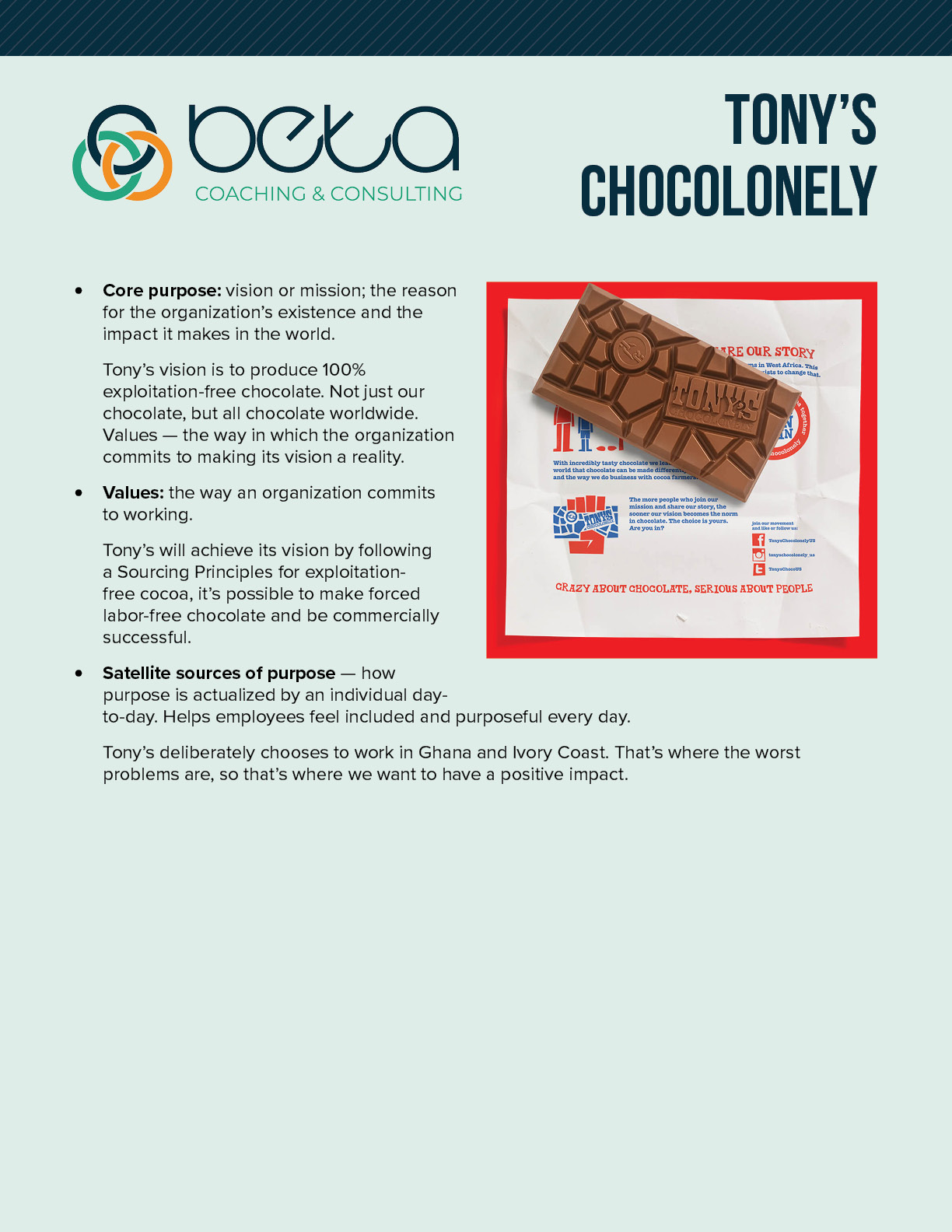When an organization views its purpose as a commitment they are working toward, its impact can be far-reaching both internally and externally. A successful implementation process requires a purpose-based business strategy where the proposed shared values are made explicit.
An organization’s purpose statement clearly demonstrates what it stands for. It should not be a branding exercise, nor should it be intended to capture more market share. It is about the direction that orients an entire community of people toward an aspired future by undertaking a period of authentic discovery modeled on the organization’s values.
Employees need to understand what the company’s purpose means for them and how it connects with the business strategy. They need to explain it in their own words without changing the meaning. When employees feel integral to this experience, there is alignment with the organization’s purpose. If not, they will experience heightened stress or other well-being concerns and likely leave the organization.
Leaders who demonstrate curiosity to listen.
Organizations that have a deep sense of purpose and have achieved alignment with their employees’ purpose have a more engaged workforce that is whole-heartedly and fully involved.
❝ [Organizations] are truly made up of people.
So, if you want people to be fully engaged, really committed
… what you need is not simply their hands …
… but their head, heart, and hands …
It takes a commitment, usually to a shared mission and this thought
of a compelling vision that they’re looking toward.❞ ~ Shundrawn
Without good communication and implementation, an organization’s purpose will ring hollow. Communication is vital, linking the organization’s internal identity, actions, and stakeholders to its external identity, actions, and stakeholders. Listening for actual or potential value alignment with colleagues allows them to feel seen and heard, which are different skills than those required for a tactical or strategic meeting.
 Creating a safe enough space for colleagues to speak up and reinforce the organization’s values is key. Building these psychologically safe teams goes hand in hand with creating positive, ethical, and purposeful environments. As leaders, understanding what your colleagues are really all about is key to curating a purpose-driven organization that effectively engages all employees.
Creating a safe enough space for colleagues to speak up and reinforce the organization’s values is key. Building these psychologically safe teams goes hand in hand with creating positive, ethical, and purposeful environments. As leaders, understanding what your colleagues are really all about is key to curating a purpose-driven organization that effectively engages all employees.
Coleman states, “corporate purpose is deeply connected to the ability of individuals to achieve greater meaning and engagement in the organizations in which they work. And for leaders who care about the well-being of their employees, and individuals who want to thrive at work, there is little more important than that.”
The happy-side benefit of aligned purpose is a flourishing, engaged workforce that knows what their organization stands for and supports it. This is deeper than the messages listed on your website. It means prioritizing and following through with practices that willfully interrogate the actions and behaviors which support the stated values and tweaks flawed or outdated practices that no longer serve the organization. Purpose makes a difference in companies only when it changes how people operate.
How is your organization living its purpose?
 I recently learned about Tony’s Chocolonely vision and was moved by its commitment to producing 100% exploitation-free chocolate. While your organization might not be in the chocolate business, its purpose can be equally dynamic, guiding internal and external stakeholders’ daily actions. This example is provided for your consideration as your think about your purpose statement.
I recently learned about Tony’s Chocolonely vision and was moved by its commitment to producing 100% exploitation-free chocolate. While your organization might not be in the chocolate business, its purpose can be equally dynamic, guiding internal and external stakeholders’ daily actions. This example is provided for your consideration as your think about your purpose statement.

 This is a beautiful meditative read that I will revisit many times! Rick Rubin shares 78 thoughts in The Creative Act: A way of being, stating that being creative is a fundamental aspect of being human. We exist in a creative universe. A mysterious realm beyond our understanding in a society that wants to make meaning out of everything.
This is a beautiful meditative read that I will revisit many times! Rick Rubin shares 78 thoughts in The Creative Act: A way of being, stating that being creative is a fundamental aspect of being human. We exist in a creative universe. A mysterious realm beyond our understanding in a society that wants to make meaning out of everything.
Being in the world and appreciating the wisdom of nature when it is noticed, awakens our creative nature. Our creative energy. Rubin inspires the reader to lean into their awareness of the multiple options available to them and become attuned to their intuitive knowing.
At the onset of the book, he states that nothing written here is known to be true … and each of the thoughts shared is an invitation for further inquiry, a zooming out or in for a new way of being. To create is about playing to play. It is about innovating and self-expression.
How are you creating an environment where you’re free to express what you’re afraid to create?
Book A Discovery Session
 A discovery session is largely influenced by a kaizen process, a philosophy based on the concept that change for the better is fostered through small modifications that create improvements. The session is centered on learning about one another, including your values, goals, and processes.
A discovery session is largely influenced by a kaizen process, a philosophy based on the concept that change for the better is fostered through small modifications that create improvements. The session is centered on learning about one another, including your values, goals, and processes.
The discussion will help determine our chemistry match and how collaborating will add value for you. There will be an opportunity to understand your needs and what is top of mind for you, especially what it is that you wish to improve upon. This is an opportunity for us to co-create a win-win partnership.
Some discovery session questions are:
- What is your biggest challenge as it relates to ______?
- How are you feeling about this challenge?
- What about solving the challenge is most important to you?
- How will you benefit from finding a solution to this challenge?
To schedule your no-obligation appointment, email novelette@betacoachingconsulting.com or visit our calendar to book an available time.
